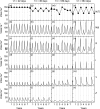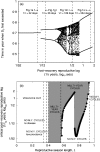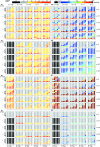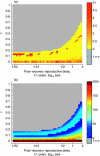Disease effects on reproduction can cause population cycles in seasonal environments
- PMID: 18005128
- PMCID: PMC2408661
- DOI: 10.1111/j.1365-2656.2007.01328.x
Disease effects on reproduction can cause population cycles in seasonal environments
Abstract
1. Recent studies of rodent populations have demonstrated that certain parasites can cause juveniles to delay maturation until the next reproductive season. Furthermore, a variety of parasites may share the same host, and evidence is beginning to accumulate showing nonindependent effects of different infections. 2. We investigated the consequences for host population dynamics of a disease-induced period of no reproduction, and a chronic reduction in fecundity following recovery from infection (such as may be induced by secondary infections) using a modified SIR (susceptible, infected, recovered) model. We also included a seasonally varying birth rate as recent studies have demonstrated that seasonally varying parameters can have important effects on long-term host-parasite dynamics. We investigated the model predictions using parameters derived from five different cyclic rodent populations. 3. Delayed and reduced fecundity following recovery from infection have no effect on the ability of the disease to regulate the host population in the model as they have no effect on the basic reproductive rate. However, these factors can influence the long-term dynamics including whether or not they exhibit multiyear cycles. 4. The model predicts disease-induced multiyear cycles for a wide range of realistic parameter values. Host populations that recover relatively slowly following a disease-induced population crash are more likely to show multiyear cycles. Diseases for which the period of infection is brief, but full recovery of reproductive function is relatively slow, could generate large amplitude multiyear cycles of several years in length. Chronically reduced fecundity following recovery can also induce multiyear cycles, in support of previous theoretical studies. 5. When parameterized for cowpox virus in the cyclic field vole populations (Microtus agrestis) of Kielder Forest (northern England), the model predicts that the disease must chronically reduce host fecundity by more than 70%, following recovery from infection, for it to induce multiyear cycles. When the model predicts quasi-periodic multiyear cycles it also predicts that seroprevalence and the effective date of onset of the reproductive season are delayed density-dependent, two phenomena that have been recorded in the field.
Figures





Similar articles
-
Host-parasite biology in the real world: the field voles of Kielder.Parasitology. 2014 Jul;141(8):997-1017. doi: 10.1017/S0031182014000171. Epub 2014 Mar 10. Parasitology. 2014. PMID: 24612619 Free PMC article. Review.
-
Delayed density-dependent season length alone can lead to rodent population cycles.Am Nat. 2006 May;167(5):695-704. doi: 10.1086/503119. Epub 2006 Mar 20. Am Nat. 2006. PMID: 16671013
-
Age-related effects of chronic hantavirus infection on female host fecundity.J Anim Ecol. 2015 Sep;84(5):1264-72. doi: 10.1111/1365-2656.12387. Epub 2015 Jun 15. J Anim Ecol. 2015. PMID: 25965086
-
Cowpox virus infection in natural field vole Microtus agrestis populations: significant negative impacts on survival.J Anim Ecol. 2008 Jan;77(1):110-9. doi: 10.1111/j.1365-2656.2007.01302.x. J Anim Ecol. 2008. PMID: 18177331 Free PMC article.
-
The population biology of parasite-induced changes in host behavior.Q Rev Biol. 1988 Jun;63(2):139-65. doi: 10.1086/415837. Q Rev Biol. 1988. PMID: 3045862 Review.
Cited by
-
Borrelia afzelii alters reproductive success in a rodent host.Proc Biol Sci. 2018 Aug 1;285(1884):20181056. doi: 10.1098/rspb.2018.1056. Proc Biol Sci. 2018. PMID: 30068677 Free PMC article.
-
Host-parasite biology in the real world: the field voles of Kielder.Parasitology. 2014 Jul;141(8):997-1017. doi: 10.1017/S0031182014000171. Epub 2014 Mar 10. Parasitology. 2014. PMID: 24612619 Free PMC article. Review.
-
Population-level differences in disease transmission: a Bayesian analysis of multiple smallpox epidemics.Epidemics. 2013 Sep;5(3):146-56. doi: 10.1016/j.epidem.2013.07.001. Epub 2013 Jul 25. Epidemics. 2013. PMID: 24021521 Free PMC article.
-
Of lemmings and snowshoe hares: the ecology of northern Canada.Proc Biol Sci. 2011 Feb 22;278(1705):481-9. doi: 10.1098/rspb.2010.1992. Epub 2010 Oct 27. Proc Biol Sci. 2011. PMID: 20980307 Free PMC article. Review.
-
No strong associations between temperature and the host-parasite interaction in wild stickleback.J Fish Biol. 2022 Sep;101(3):453-463. doi: 10.1111/jfb.15107. Epub 2022 Jul 15. J Fish Biol. 2022. PMID: 35598110 Free PMC article.
References
-
- Altizer S, Dobson A, Hosseini P, Hudson P, Pascual M, Rohani P. Seasonality and the dynamics of infectious diseases. Ecology Letters. 2006;9:467–484. - PubMed
-
- Anderson RM, May RM. The population-dynamics of micro-parasites and their invertebrate hosts. Philosophical Transactions of the Royal Society of London, Series B, Biological Sciences. 1981;291:451–524.
Publication types
MeSH terms
Grants and funding
LinkOut - more resources
Full Text Sources
Other Literature Sources

